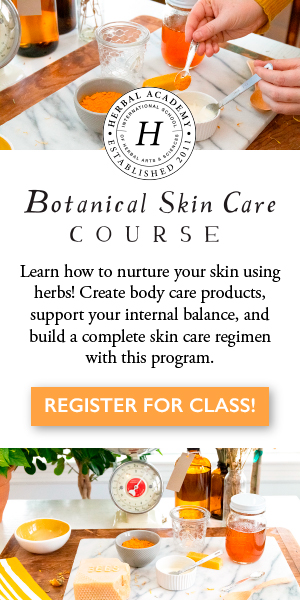
by Leslie Moldenauer | | Essential Oils
Congratulations, Mom! Motherhood, whether for the first time the fourth time, or anywhere in between, is one of the most exhilarating times in a woman’s life. Be sure to slow down and savor every moment of it, not only because everything goes by so fast, but also because it is a crucial time to take care of self. Postpartum Depression..The Importance of Asking for Help
If you are sporting your baby bump and are knee deep in preparation, I want to cover a very important topic, postpartum depression (PPD). The rates of women who are affected by PPD are staggering, and constantly on the rise. According to a study performed in 2017 by the CDC, approximately one in nine women currently experience symptoms of PPD [1]. These numbers are very significant, and the topic needs a big, glaring spotlight put on it.
*If you think you may be suffering from PPD, please see your doctor.
As women, “most” of us are not prepared for motherhood in the way I am about to discuss. Other than books and articles preparing us for Baby, such as the best seller, “What To Expect When Expecting,” there is not much at all by way of truly preparing us moms for this huge life shift. I am speaking emotionally, mentally and physically. We can find information in books regarding cracked nipples, perineum tears, how long to wait before sex, stretch marks and hemorrhoids, but ladies; we need so much more than that! During this important time, I am not sure how many of us really think about ourselves as the most important one! It is crucial that you begin to see it that way, even with that brand-new life that you have made and is about to be in your arms nearly 24-7! Prepare to take impeccable care of self, for your health and sanity, as well as everyone else’s around you.
In sweet anticipation of the new baby on the way, we make lists of what baby needs; the A-Z of the cornucopia of “stuff” needed to support the new life in the home. After birthing our offspring, we throw ourselves into their care with abandon. With this, we second guess if we are doing everything right. We agonize over why they are crying, and we may even worry about how other moms perceive us. In addition to this emotional conflict, we attempt to place them in a proverbial bubble, so they do not get sick, although this tends to be a phenomenon most prominent with the first-born. Through all of this, our own well being often takes a back seat, or maybe even the trunk.
It is an extraordinary moment when we allow ourselves to stop the world around us. If only for a minute, to capture a coy smile that appears while our babe is sound sleep, or to look into his or her eyes and really see their soul, or just take a few moments to daydream, pondering the miracle of life. Try to embrace more of these moments.
We are encouraged to sleep when the baby sleeps or take time for self-care. How many of you, who have been through this already, just thought, “Like I could ever have found time for that.” Everyone offers advice on what you “should” be doing, solicited or otherwise. It is easy to offer advice to others, but not always so easy to enforce it in your own life.
I am not necessarily saying that naps are the answer. I have never been much of a napper unless I was up all night with a growth spurt feeder, sick baby or under the weather myself. So, if you have had a particularly rough night, then perhaps yes, that is what would be of most benefit to you.
What I am really talking about here is true, self-care: no chores, no laundry, and no dishes. Perhaps a bath or a nice hot shower followed by moisturizing the newly sensitive areas is just what you need.
Perhaps you can take a seat outdoors for a little bit of vitamin D and complete silence or take a walk while Baby naps in the stroller. While you walk, be sure to not go over the to-do list for once you arrive back home but take that time while your feet are hitting the pavement to look around you, soak up the sun and sounds, and truly rest your mind. When you get back home, read a book, have a nice warm cup of tea; something that helps you to slow down and supports your ability to truly unwind. Remind yourself how important you are during this time that is making many extra demands on you physically and emotionally. Maybe some self-pleasure is in order. Endorphins will do amazing things for any goddess! Remove the phrase, “I do not have time,” from your vocabulary; you are worth making the time.
*Challenge:
In addition to your A-Z list of things that Baby needs, I challenge you to make your own A-Z list. When the house is quiet, sit down and make your list, something like this:
A. Ask for help, art, allow stillness, acupuncture
B. Bath, breath work, breast massage, book, Be
C. Candles, call a friend, cuddle in a warm blanket, cake, chakra cleansing, cook a healthy meal, create a special space, color
D. Dance, date night, “Dear self” letters
Try it, A-Z. Expand on it regularly. Put it somewhere where you will see it often and try to do a few of them every day.
What else can you do for yourself?
Healthy Eating
Eating a healthy diet is critical. I know from experience how you feel, completely exhausted and grabbing a quick snack when hungry is ideal, in theory. But an apple with peanut or almond butter, for example, is going to sustain you much longer than reaching for something sugary sweet or another option full of carbs.
Making sure to get a balance of B vitamins is recommended. A recent study published in 2013 showed that increased levels of homocysteine showed a higher correlation with PPD [2]. What is homocysteine? It is an amino acid that has been shown to cause inflammation. The B vitamins help the body to metabolize homocysteine, specifically B6, and B12. You can obtain B6 in foods such as eggs, vegetables, and clean dairy, but B12 may need to be taken in supplemental form. If you are at high risk for PPD, or have suffered in past pregnancies, please ask your doctor to test your levels.
Ask For Help
If you are anything like me, a strong, confident and very stubborn woman, you may find yourself thinking, “I’ve got this. I do not need any help.” Or possibly you do ask for help, and then it does not get done the way you would have done it, and you say to yourself, “Nothing gets done right around here unless I do it myself!”
Let’s try reframing those thought patterns. I like reframing because it gives space for new ways of thinking or new outlooks that you may have never thought of before. Thinking that you need to change the core of who you are can be met with resistance, and understandably so. You can try something new and see if it feels good. Give it a try!
Ask for help! It could be as simple as calling a friend and asking him or her to make a meal, pick up take-out, or take the baby for a walk so you can take a bath! You are human, so let the notion of, “I can do it all by myself,” go. I will not argue the fact that you can, in fact, do it all by yourself, but at what expense is the question.
Closing
Find my latest book written just for you mom, filled with information like this and more, to support you and your loved ones. There is a multitude of other things that you, mom, can do to prepare yourself for baby and be the healthiest you possible.
Like so many practices in life, I encourage you to become educated on the proper use of essential oils. When using them, please do so cautiously, understanding that there is often misinformation on the internet. You can be assured that I support only educated and proven resources. While essential oils should not be feared they should be respected and used properly to ensure the safety of the individuals using them.
Please note that I am not a medical practitioner. The content of this website is provided for general informational purposes only and is not intended as, nor should it be considered a substitute for, professional medical advice. Do not use the information on this website for diagnosing or treating any medical or health condition. If you have or suspect you have a medical problem, promptly contact your professional healthcare provider. By using this website, you assume full responsibility and liability for your own actions.

References
[1] Trends in postpartum depressive symptoms-27 states, 2004, 2008, and 2012
[2] Aishwarya, S. et al (2013) Homocysteine and serotonin: association with postpartum depression. Asian Journal of Psychiatry. Dec;6(6):473-7
BEFORE YOU GO! Remember to sign up for my FREE Facebook group! Hang out with me and THOUSANDS of other Essential Oil lovers looking to learn, click on to join Real Essential Oil Education Group!
Check out my FREE offer below!
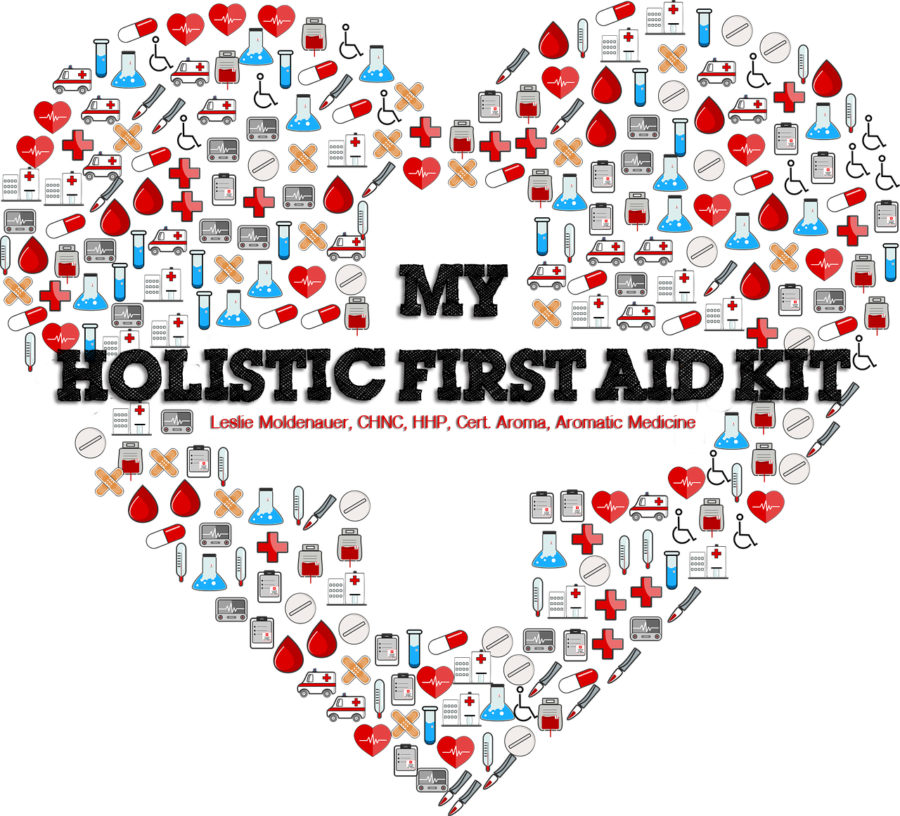
by Leslie Moldenauer | | Essential Oils
The variety of choices for a holistic first aid kit is quite exciting for the DIY’er in you and goes well beyond essential oils. Just about anything can be handled well with holistic remedies, and there are a plethora of options. I will be going over at a few of those options today. If we have the choice of handling things at home and do not have to travel to a doctor’s office where there is oftentimes a myriad of germs, let’s give it a go, right? I think it is important to understand when getting medical care is needed, but it is not always needed. My Holistic First Aid Kit II
This is my 2nd installment of this popular blog, as there are so many exciting things to share. You can find the first version here.
Homeopathic Medicine
What is homeopathic medicine? The word homeopathy, which comes from the Greek language, through Latin, and into English, means “like disease”. The guiding principle of homeopathy is stated as “let likes cure likes” (1). The foundation of homeopathy states that if a substance can cause disease in healthy people it will cure those same similar symptoms in sick people. It can be compared to a vaccine, without all the additives that are very much a health concern. Homeopathic medicine comes in varying strengths, but they are all considered the “minimum dose”.
“Homeopathic medicines are prepared through a series of dilutions, at each step of which there is a vigorous agitation of the solution called succus on until there is no detectable chemical substance left. As paradoxical as it may seem, the higher the dilution, when prepared in this dynamized way, the more potent the homeopathic remedy. Thereby is achieved the minimum dose which, none the less, has the maximum therapeutic effect with the fewest side effects” (2).
It is important to note that there are literally hundreds of varieties of single doses and mixed doses of homeopathy. If one type is not working for you, it does not necessarily mean that homeopathy does not work, but that you do not have the proper remedy. And much like essential oil, homeopathy is not a simple fix for any ailment; it is meant to be complementary care.
I have a homeopathic kit with me at all times of varying sizes. I have one kit in my home, one in my car and a few vials in my purse. In my first article, I listed Arnica Arnica Montana and Nux Vomica. Those are my top two homeopathic remedies used, you can find out why here. But those are not the only ones I keep in the home.
I love the line called Kid’s Relief® (not an affiliate) (3). The remedies are liquid, so easily for littles to take, and I have found great benefits to a number of them (I have placed an asterisk next to the ones I have tried and like). Here is what they carry.
Allergy Oral Liquid*
With Calming Effect Medicine*
Colic Oral Liquid*
Cough and Cold Medicine*
Nighttime Cough and Cold Medicine*
Earache Oral Liquid
Flu Relief Flu Oral Liquid
Pain & Fever Relief Pain & Fever Oral Liquid
Teething Oral Liquid*
I have found great success with the Kid’s Relief® line, and they all taste good too.
Want to learn more about homeopathic remedies? Check out the information listed in the resources below.
*Want to know what dilution to go with? Follow this link for more information.
Herbs
I utilize my large storage space of herbs in a variety of ways in the home. I make many infused oils that sit in mason jars soaking up the summer sun like Arnica (Arnica Montana), Rose Hips (Rosa canina), and Calendula (Calendula officinalis). During the months that the sun is a bit farther out of reach, I utilize my crock-pot on the keep warm setting. I like soaking dried calendula flowers in an apricot carrier oil, sealing in a mason jar and placing in the sun a few hours daily (With calendula and any other herbal material, make sure it is fully dry to avoid spoilage). The jar should stay in the sun for an average of 4 weeks, shake often and continually make sure that there is no moisture present. Strain well, using cheesecloth and pour into sterilized bottles. Calendula infused oil is great for inflammation and pain, as well as scrapes, scratches, burns, and bites. I use this oil as a base for many of my other products as well. Calendula can be incorporated into baths, creams, compresses, washes, salves, ointments, massage oils, baths, facial steams, tinctures, and teas. It is also gentle enough to use for babies, children, or animals (4).
*Calendula is mentioned in my first article, but is so crucial and used so often that I needed to keep it here too.
There are times in a pinch where I forage for a fresh herb (what some consider a weed) for a quick remedy. Plantain (Plantago major) is one of my most often used weeds. You will likely be able to find it in your yard or your neighbor’s, and definitely growing out in the wild. In a pinch (bee sting crying child moment) I have grabbed a leaf of plantain, chewed it up to activate the juices of the leaf and placed the contents on the bite for immediate relief. Then used as a poultice to keep swelling down and pain at bay while it healed.
When not in a pinch, you can collect the leaves, clean and dry them, and use them in a tea/decoction for an upset stomach, and the leaves are super nutritious, tastes great fresh in a salad. You will likely be shocked with all of the uses for this common weed….NATURE IS AMAZING….read more about it here.
Another weed that I utilize when foraged for is Purslane (Portulaca oleracea). The leaves resemble a jade plant. I have actually been known to plant the seeds in my garden! If you want to try it, just be sure not to let it go to seed, or you will have a really hard time controlling it. You will want to pick the young leaves and eat them. They are incredibly nutritious (5).
Purslane is rich in Omega-3’s, more so than any other leafy green! This makes it incredibly useful for any inflammatory condition, think ‘itis’. I love using purslane in a poultice for my local clients with eczema and psoriasis. It is incredibly soothing and healing. Before I reach for any essential oil, this is my go-to for burns obtained in the kitchen. Crush up a few leaves in your mortar and pestle and apply directly to the affected area. Follow this link to learn more about this incredible weed.
*IMPORTANT If you are foraging for weeds
#1-Make absolutely sure that you have correctly identified your plant. If you are unsure, take a novice with you to forage, or skip that plant altogether.
#2-Make sure that where you are taking from has not been fertilized, and you are well away from any industrialized area or street.
#3-A personal recommendation of mine is to never take the whole plant. You always want to encourage the plant to continue growing. Always consider mother earth in everything you do.
Other herbs worth mentioning…..
Just like with your own children a nighttime ritual before bed is often very helpful to settle. If you are running around the home picking things up, making lunches, folding laundry, paying bills and the million other things we moms do, it is going to be hard to shut the switch off right when you lay down and go to sleep. Try teatime. Turn off all electronics at least 30 minutes before lying down. You could sit in silence, read a small passage of a feel-good book, or journal a gratitude list for the day. (To-do lists are not welcome here.)
Passionflower (Passiflora incarnate) is an absolutely gorgeous flower, and in the dried herbal form, it is beneficial to calming the mind. As a matter of fact, “Scientists believe passionflower works by increasing levels of a chemical called gamma-aminobutyric acid (GABA) in the brain. GABA lowers the activity of some brain cells, making you feel more relaxed” (6).
Passionflower is also a beautiful herb for anxiety, but there are a few contraindications to be aware of. This herb is not for anyone who is currently pregnant or breastfeeding. If you are already taking anti-anxiety medication, anti-depressants, or any other sedating medication, avoid passionflower in your cup, or you could greatly intensify the effects of your medication.
Lemon balm (Melissa officinalis) in your tea is a must! Touted for relaxation of body and mind. Fun fact! In Germany, lemon balm is licensed as a standard medicinal tea for sleep disorders (7).
The essential oil, typically sold as Melissa, is amazing too, but rather costly. Many do not know that it takes quite a lot of plant material to fill that bottle, so I recommend using the herb to help calm before bed. Like Passionflower, if you are taking sedating medications, adding herbal sedatives to the cocktail is not a good idea.
Chamomile (Chamaemelum nobile) is another favorite for calming the body, mind…and bonus, the belly! Use caution if you have an existing ragweed allergy or hay fever, chamomile may affect you as well.
Some recommend Valerian (Valeriana wallichii) …but I think the herb tastes awful, and the essential oil smells even worse.
Use Catnip (Nepeta cataria) instead!
Catnip is rich in nepetalactone, which has mild but effective sedative qualities, and acts much like valerian! (8)
If you mix equal parts of a couple, a few, or all of these herbs and enjoy teatime before bed, you might find yourself much more inclined to sleep peacefully. You may or may not consider this ‘first-aid’, but as a mom that often wears her cape too often, getting enough sleep is crucial to functioning, being happy and healthy…so I definitely place a sleep aid in the category of first-aid.
Local Honey Syrup for Allergy Relief
I am not a proponent of allergy medications unless absolutely necessary, and sometimes it is…but I do recommend trying natural remedies first. Making a honey syrup from local honey can be extremely useful here.
First, make sure what you are purchasing is raw honey, and make sure it is truly local. Why? Raw honey will still contain all the yummy and therapeutic living enzymes needed when combatting histamine reactions.
Why Local? You want honey harvested near the plants that grow locally to your area, the ones that are causing your allergies. It is also a good consideration to but it seasonally for this exact same reason.
You can make fun frozen popsicles from frozen berries and add your honey, but I prefer to mix some of my local honey with fresh lemon juice and take by the spoonful. It is amazing for the post nasal drip and nighttime cough too.
Essential Oils
I am a stickler for essential oil safety, so I will not be recommending applying essential oils to scrapes/cuts, or to use them undiluted.
In my first article, I covered Lavender (Lavandula angustifolia), Helichrysum (Helichrysum italicum), and Kunzea (Kunzea ambigua).
Essential oils are great for the home first-aid kit, but what about hydrosols?
Roman chamomile (Chamaemelum nobile) hydrosol can be added to a babies bath for red irritated skin on the bum or the head.
Lavender (Lavandula angustifolia) can be used as a part of a nighttime massage routine, used to cleanse cuts and scrapes whereas you can not do that with the essential oils counterpart (9). Suzanne Catty, author of Hydrosols, the Next Aromatherapy talks about these uses and many more for babies and young children (adults too). A book I highly recommend (link in resources).
Hydrosols are not as easy to take on the go, so what are a couple of other essential oils that I like?
I carry a couple of roller ball blend at 3% for my boys. One rollerball is for a headache, the other for an upset stomach. Here are my blends:
Headache (Master blend)
*Peppermint (Mentha piperita) 15 drops
*(Not for little children, replace with Spearmint (Mentha spicata) if needed)
Lavender (Lavandula angustifolia) 15 drops
Sweet Orange (Citrus sinensis) 15 drops
Frankincense (Boswellia carterii) 10 drops
Cedarwood (Cedrus Atlantica) 10 drops
This is a total of 65 drops and will fit in a 5ml bottle to store in the fridge.
*It is important to mention that there are various types of headaches. Not one blanket blend is going to work across the board, in most instances. A headache we are typically dealing with is sinus pressure related and it usually is upsetting to them emotionally; luckily we do not frequently get them.
Stomachache (Master blend)
*Peppermint (Mentha piperita) 15 drops
*(Not for little children, replace with Spearmint (Mentha spicata) if needed)
Cardamom (Ellettaria cardamomum) 15 drops
Ginger (Zingiber officinale) 10 drops
Roman Chamomile (Chamaemelum nobile) 5 drops
This is a total of 45 drops and will fit in a 5ml bottle to store in the fridge.
*A bit part of the remedy here is the belly massage, combines with an inhalation of the oil blend rubbed into the belly or held under the nose.
Closing
I hope that these basic ideas are helpful for you to begin to make your own first aid kit, one for home and one for when your away. There are many other things that can be utilized, what would you include in yours?
Like so many practices in life, I encourage you to become educated on the proper use of essential oils. When using them, please do so cautiously, understanding that there is often misinformation on the internet. You can be assured that I support only educated and proven resources. While essential oils should not be feared they should be respected and used properly to ensure the safety of the individuals using them.
Please note that I am not a medical practitioner. The content of this website is provided for general informational purposes only and is not intended as, nor should it be considered a substitute for, professional medical advice. Do not use the information on this website for diagnosing or treating any medical or health condition. If you have or suspect you have a medical problem, promptly contact your professional healthcare provider. By using this website, you assume full responsibility and liability for your own actions.

References
(1) (2) What is homeopathic medicine? Retrieved from http://homeopathyusa.org/homeopathic-medicine.html
(3) http://www.kidsrelief.com/
(4) Healing with Calendula, (2010) Retrieved from
http://mountainroseblog.com/healing-calendula/
(5) Portulaca oleracea. Retrieved from https://en.wikipedia.org/wiki/Portulaca_oleracea
(6) Passionflower. Retrieved from http://www.umm.edu/health/medical/altmed/herb/passionflower
(7) Blumenthal, M. (2000). Herbal medicine: expanded commission e monographs. Austin: American botanical council. (pp. 230-232)
(8) Catnip. Retrieved from https://www.anniesremedy.com/nepeta-cataria-catnip.php
(9) Catty, S. (2001). Hydrosols: The next aromatherapy. Rochester, VT: Healing Arts Press.
BEFORE YOU GO! Remember to sign up for my FREE Facebook group! Hang out with me and THOUSANDS of other Essential Oil lovers looking to learn, click on to join Real Essential Oil Education Group!
Check out my FREE offer below!
Herbal Resources
Adaptogens: Herbs for Strength, Stamina, and Stress Relief by D. Winston
Botanical Safety Handbook, 2nd ed. By AHPA (American Herbal Products Association)
Healing Wise (Wise Woman Herbal) by. S. Weed
Herbal Antibiotics, 2nd Edition: Natural Alternatives for Treating Drug-resistant Bacteria by S. Buhner
Herbal Antivirals by M. Jones
Herbal Medicines: A Guide for Health-Care Professionals by C. Newall, L. Anderson, and D. Phillipson
Herbs for Common Ailments: How to Make and Use Herbal Remedies for Home Health Care by R. Gladstar
Herbal Teas: 101 Nourishing Blends for Daily Health & Vitality by K. Brown
Medical Herbalism: The Science Principles and Practices Of Herbal Medicine by D. Hoffmann
Principles and Practice of Phytotherapy: Modern Herbal Medicine, 2e by K. Bone and S. Mills
Rosemary Gladstar’s Family Herbal: A Guide to Living Life with Energy, Health, and Vitality
Rosemary Gladstar’s Herbal Recipes for Vibrant Health
Rosemary Gladstar’s Medicinal Herbs: A Beginner’s Guide
Homeopathic Resources
Classical Homeopathy by M. Carlston
Complete Homeopathy Handbook by M. Castro
Encyclopedia of Homeopathy by A. Lockie
Homeopathy Pocket Guide by A. Brandl
Principles and Practice of Homeopathy by D. Owen
Hydrosol Resource
Hydrosols, the Next Aromatherapy, by Suzanne Catty
[mailpoet_form id=”2″]
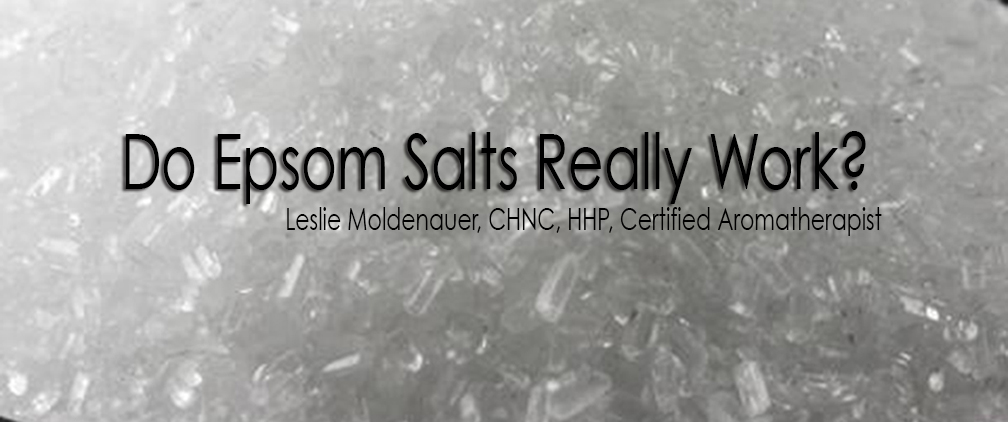
by Leslie Moldenauer | | Essential Oils
There are times where we all fall suspect to confirmation bias when it comes to what we are told in regards to natural remedies. We may know that there are indeed specific benefits to a remedy, we may have even experienced a few of them firsthand, but those benefits can oftentimes be extrapolated beyond what is scientifically shown. Do Epsom salts really work?
I personally know through experience, that there are benefits for me, I will explain more in a little bit, but the detoxifying claim always left me scratching my head….so I decided to do a little digging about all of the claims on my own.
Epsom salt is magnesium sulphate heptahydrate, usually shortened just to magnesium sulphate. We know magnesium is a mineral with many benefits to the human body. A study performed in 2005 with The Journal of the American College of Nutrition showed that nearly 70% of Americans consume less than the daily RDA of magnesium, and showed that this deficiency is a marker for increased inflammation [1].
What is the importance of this mineral in the human body?
The following is according to the reputable site, MedLine Plus:
“Magnesium is needed for more than 300 biochemical reactions in the body. It helps to maintain normal nerve and muscle function, supports a healthy immune system, keeps the heart beat steady, and helps bones remain strong. It also helps regulate blood glucose levels and aid in the production of energy and protein” [2].
What are some symptoms of a magnesium deficiency in the body? Magnesium deficiency, also known as hypomagnesemia, is not something that is talked about very often. We typically hear more about being deficient in vitamins B, C, and D before we hear about magnesium. This is not due to lack of importance.
Muscle twitches and cramps
Low levels of magnesium, as well as calcium and potassium, can cause muscle twitches and cramps, and when severe enough this can be termed tetany [3] [4].
Those of us that are physically active and wake in the middle of the night with a charlie horse knows that our body is telling us something. It is telling us that we are dehydrated, but it is not only water that we need but minerals, electrolytes.
*It is important to note that magnesium deficiency is not the only cause of muscle twitching.
Fatigue and muscle weakness
Fatigue and muscle weakness can potentially describe all of us sometimes, like when outdoors in the heat…or well, just being a mom sometimes, am I right? So it is important to note that the fatigue and muscle weakness we are talking about here is severe and unrelenting, lasting more than a day or two.
The reason for the extreme fatigue and weakness is believed to actually be from a lack of potassium in the cells, which coincides with low magnesium levels [5].
*If your symptoms are severe, please be sure to see a doctor.
Blood pressure
This study published in 2016, showed that a deficiency in magnesium can contribute to higher blood pressure, and obtaining the RDA can help to lower it [6].
For this reason, we might want to utilize caution in a bath full of Epsom salt if we already have low blood pressure, which I do..on average my bp is 105/75. If I add too much salt to the water and soak for too long in too warm of water, I get lightheaded, dizzy, and have even had episodes of irregular heartbeats. Due to the temperature of the water or the salts? Both? What do you think?
Irregular heartbeat
Scientists believe that irregular heartbeats are actually due to an imbalance of potassium levels inside and outside of heart muscle cells, a condition associated with, you guessed it..a deficiency in magnesium [7].
What have you noticed in all of the symptoms that I have just described above? (not an all-inclusive list of magnesium deficiency) Magnesium does not act alone. It is very much a balance of magnesium, potassium, and calcium that we should aim for. Getting one more than another may not be the answer, it could only serve to further throw off the delicate balance of minerals in the body. Good health is all about balance.
Relaxation
The main push for magnesium in a bath is for relaxation. How does magnesium relax us? We are again reminded of balance. Calcium and magnesium work harmoniously together. Internally, calcium excites our nerves, promoting muscle contractions. Magnesium does the opposite by calming nerves and promotes our muscles to relax [8].
Many people question how much magnesium we are absorbing to actually help with sore muscles or even relaxation. How much of it is placebo? Is it just the warm water? The essential oils? The power of the mind? What have you experienced?
I am not at all against Epsom salt baths, I am actually a fan! Whether placebo of scientific fact, I have experienced benefits, so for today I am going with that!
Can Epsom salts really detoxify us?
Detox has become quite the buzzword online and on social media. There is so much misinformation, it is important to look at things with a critical eye. You can very easily find claims online that Epsom salts can pull out toxins from the body, but how would this claim work?
Outside of magnesium providing a laxative effect if consumed internally or even possibly soaking too long with too many salts, this is a very far-fetched claim with no scientific evidence to back it up. Websites state that your body absorbs the minerals through the skin, and the minerals then draw out toxins. For those of you who have taken anatomy and physiology know that this is somewhat improbable. What toxins are being drawn out, and how?
In regards to our integumentary system, not everything we put on our skin is fully absorbed into our bodies. If this were the case, we would swell up while soaking in the bathtub, and swimming in a pool full of chlorine would…well…let’s just say it would not end well. Our skin is somewhat waterproof for a lack of a better term.
A phenomenon to also consider, looking at the flip side, is when we sit in the bathtub for an extended period of time, we get quite the wrinkled look on our fingers and toes. The keratin is actually absorbing the water, but only for a short time [9]. This is also why your nails will bend easily after getting out of the bath, after a good foot soak (best time to clip em’) or after doing the dishes as your nails contain considerable amounts keratin [9].
Because of this, I think it is fair to say that we do absorb a very small amount of magnesium, which is why I can have such a strong reaction to my blood pressure if I am not careful. I have experienced the laxative effect that is touted on the bag as well just by soaking in the tub with way too much for too long on one occasion when I had really bad back spasms (The bag of Epsom salts recommends taking internally for a laxative effect).
Unless we are forcing the body to sweat excessively like in a steam or sauna, are we really detoxing in the bathtub?
*The following article tackles this concept in great detail. Rather than recreate the wheel, I ask you to read it if you still think Epsom salts can provide the body with detoxification. It is a fantastic read: Does Epsom Salt Work?
Supporting our detoxification process backed by science
We know that there are numerous ways in which our body eliminates waste. They are urine, feces, lungs, skin, and very minimally via our hair. Therefore, there are numerous ways that we do know support our body to rid it of unwanted chemicals and materials. Drinking more water is the number one thing that you can do, as it increases kidney function by increasing your output of urine. It also helps you to poop more regularly, encouraging colon health. Sweating via exercise, steam baths, and saunas as I mentioned above are also very beneficial if you can handle the heat (not the same as a bath). Exercise also helps open the lungs to facilitate deeper breathing, helping detoxification of the air we breathe.
Closing
I believe that Epsom salt baths are relaxing, and we all deserve to treat ourselves to some quality self-care, often! It is important to understand that there is simply no scientific evidence showing that there is any kind of true detoxification happening when you soak in the tub.
A very important point to remember is that the overuse of magnesium via supplements could throw off your balance of other critical minerals. Education and awareness are key, with a whole lot of balance.
Like so many practices in life I encourage you to become educated on the proper use of essential oils. When using them, please do so cautiously, understanding that there is often misinformation on the Internet. You can be assured that I support only educated and proven resources. While essential oils should not be feared they should be respected and used properly to ensure the safety of the individuals using them. Please note that I am not a medical practitioner. The content of the website is provided for general informational purposes only and is not intended as, nor should is be considered a substitute for, professional medical advice. Do not use the information on this website for diagnosing or treating any medical health condition. If you have, or suspect you have a medical problem, promptly contact your professional healthcare provider. By using this website, you assume full responsibility and liability for your own actions.

References
[1] King DE, et al (2005) Dietary magnesium and C-reactive protein levels. The Journal of the American College of Nutrition. Retrieved from https://www.ncbi.nlm.nih.gov/pubmed/15930481
[2] Magnesium in diet. Retrieved from https://medlineplus.gov/ency/article/002423.htm
[3] Vallee, B. et al (1960) The magnesium-deficiency tetany syndrome in man. The New England Journal of Medicine. Retrieved from https://www.nejm.org/doi/full/10.1056/NEJM196001282620401
[4] Han, S. (2017) What is Tetany? Retrieved from https://www.healthline.com/health/tetany
[5] Huang, CL, Hou, E. (2007) Mechanisms of hypokalemia in magnesium deficiency. Journal of American Soc Nephrol. Retrieved from https://www.ncbi.nlm.nih.gov/pubmed/17804670
[6] [7] Dyckner, T., Wester PO., (1981) Relation between potassium, magnesium, and cardiac arrhythmias. Acta Med Scand Suppl. Retrieved from https://www.ncbi.nlm.nih.gov/pubmed/6942639
[8] Standring, S. (2016). Grays anatomy: The anatomical basis of clinical practice. Philadelphia: Elsevier Limited.
[9] Why do fingers wrinkle in the bath. Retrieved from https://www.scientificamerican.com/article/why-do-fingers-wrinkle-in/
Additional Resources
Salt Soak for Detox?
No, You Can’t ‘Detox’ from an Epsom Salt Bath
The Calming Effects of Calcium and Magnesium
BEFORE YOU GO! Remember to sign up for my FREE Facebook group! Hang out with me and THOUSANDS of other Essential Oil lovers looking to learn, click on to join Real Essential Oil Education Group!
Check out my FREE offer below!
Proper Use of Essential Oils in the Bath
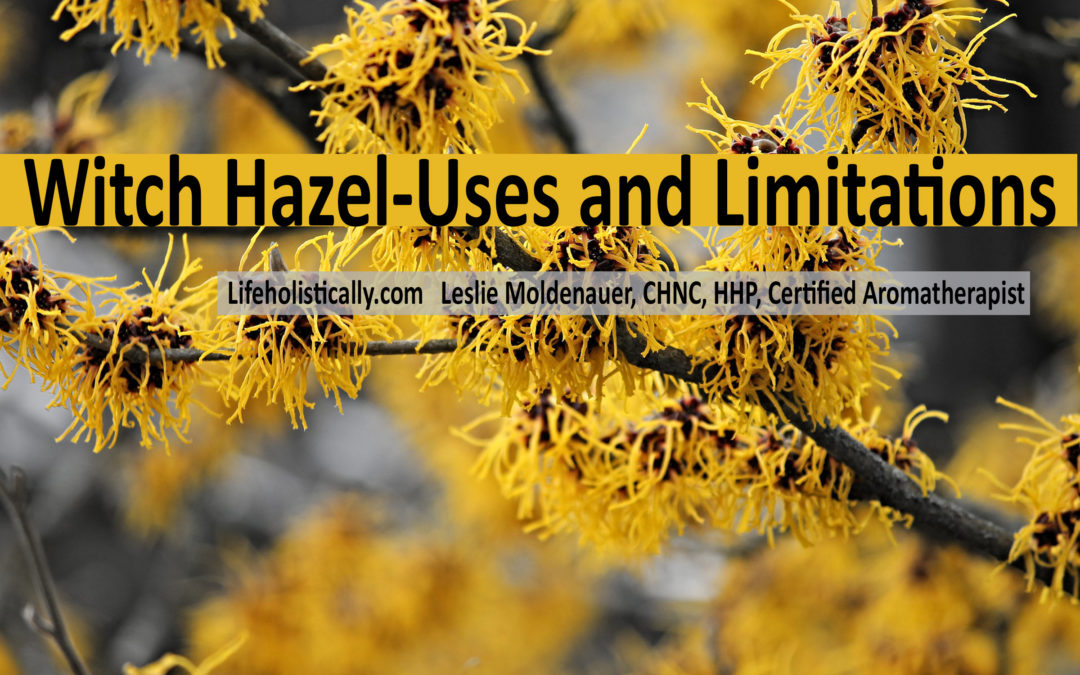
by Leslie Moldenauer | | Essential Oils
What is witch hazel? “Witch hazel is an astringent compound produced from the leaves and bark of the North American witch hazel shrub (Hamamelis virginiana). It is a component of many commercial healthcare products. Witch hazel water can be produced by maceration or distillation” [1]. Is witch hazel an emulsifier? Is witch hazel a preservative? Witch Hazel (Hamamelis virginiana)-Uses and Limitations
Witch Hazel (Hamamelis virginiana)-Uses and Limitations
Astringents are significant in skincare because they are quite efficient at the contraction of skin tissue, as a result, astringents in OTC (Over the counter) products like hemorrhoid crème and products to remove under-eye puffiness for example. You can Google the most well-known hemorrhoid crème and see that it contains a petrolatum base, along with shark liver oil, a number of other ‘stuff’, and 50% witch hazel. Witch hazel works!
We do not need all the other fillers in those products; we can purchase great quality organic witch hazel extract online and utilize it for a whole host of things. My recommendation is to purchase through Mountain Rose Herbs.
Witch hazel contains 14% alcohol, which is a really important point to remember. One may automatically think then it must be drying to the skin, but witch hazel is actually considered to be hydrating to the skin to a certain degree. One of the most popular uses aside from hemorrhoids is blemishes. It really helps to clear them up fast. How else can witch hazel be used?
When my boys were little I used witch hazel on their bottom to clear up red, itchy, irritated skin. Just be sure not to use at every diaper change as you may dry out the most sensitive skin. Two times a day and you will see a clearing of the issue quickly.
I use witch hazel as a toner on my face with a cotton round in place of soap. I have used witch hazel as a base for an after the shave lotion. Rashes, poison ivy, chickenpox, sunburn, windburn, cuts, and scrapes, you name it; witch hazel is a winner for the skin.
Some state it works great all by itself as a natural deodorant, but I admit I have not tried it in this manner….yet!
If you are familiar with working with hydrosols, you can purchase witch hazel in this form as well! According to hydrosol expert Suzanne Catty, the shelf life of witch hazel hydrosol is eight months to a year [2]. So, it is a bit shorter than witch hazel distillate, which is easily past that one year mark, and they both have all of the benefits I mentioned above and more!
Witch Hazel Limitations
Solubilizing Properties of Witch Hazel?
I wanted to be sure to address two different ways in which some state that witch hazel can be used that are not a true representation of the plants abilities. The first is that witch hazel is a proper and effective solubilizer, capable of dispersing essential oils in water. It is not. The theory is that the alcohol content within witch hazel will disperse the tiny droplets of oil in the water.
Herein lies the issue. Witch hazel contains only 14%-15% alcohol (Many on the store shelves are not alcohol-free).
DID YOU KNOW? 190 proof alcohol is what you would ideally need for it to act as a solubilizer (dispersing oils in water)? Even cheap vodka is not strong enough to help you get that done (If you have access to Everclear in your state, you are golden). If not, check this resource to get yourself some grain, grape, or cane alcohol. Witch hazel is not even coming close to being effective, as you can see in the multiple images I took below using German Chamomile (Matricaria chamomilla) for an effective visual.
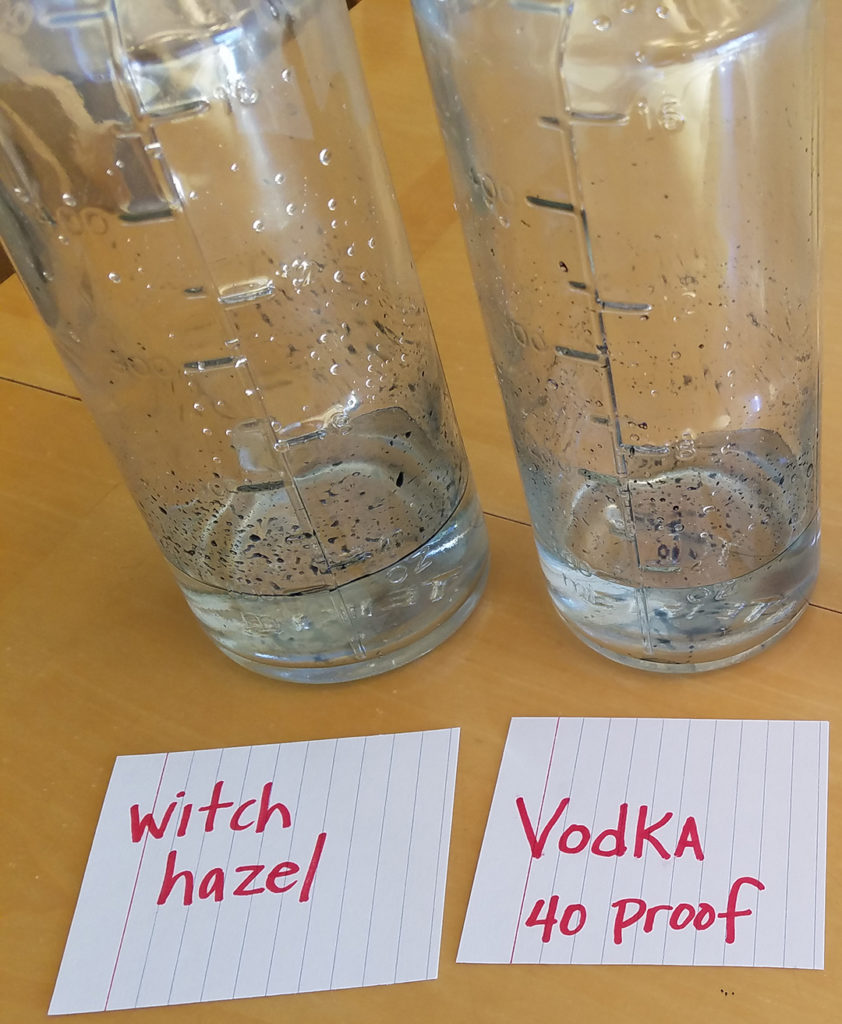
Image copyright Lifeholistically LLC
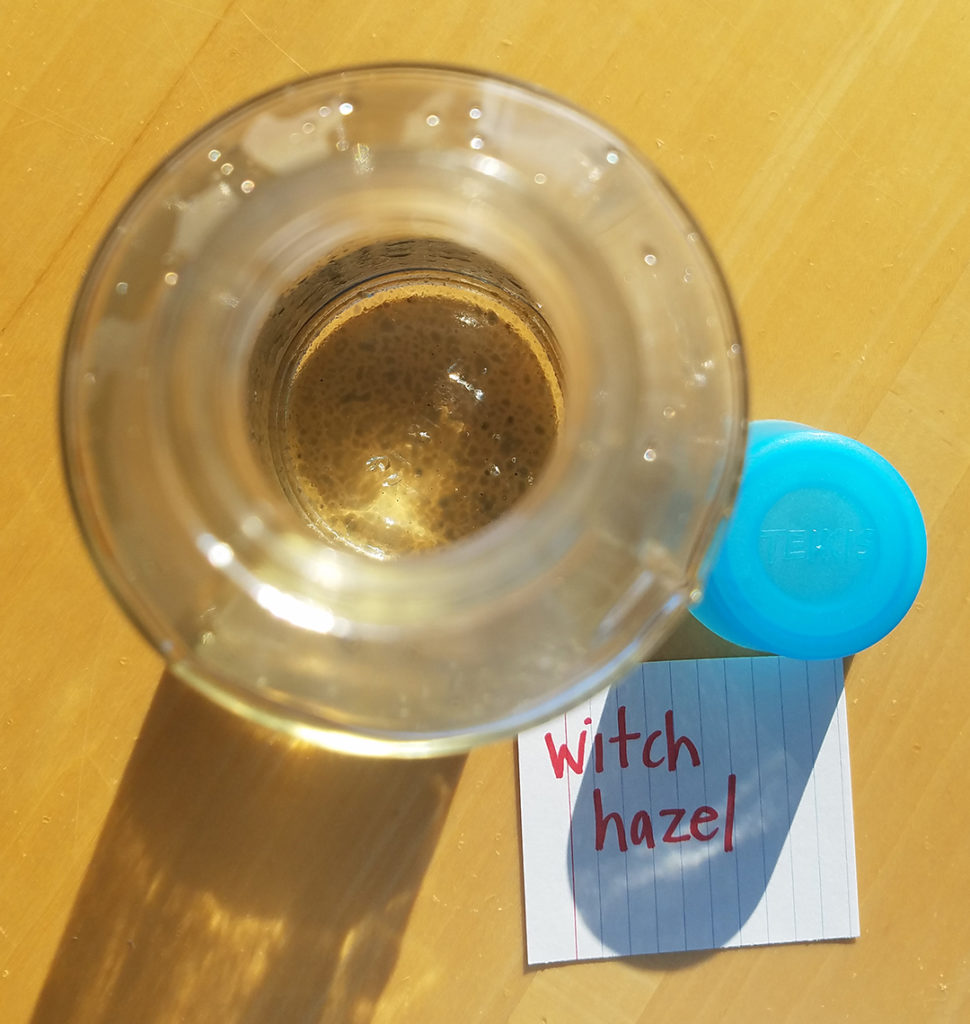
Image copyright Lifeholistically LLC
Seeing is believing, right?
Preservative Capabilities of Witch Hazel?
Some have stated that witch hazel also has preservative properties, however, this is not factual as alcohol can only preserve at very specific quantities. In order for alcohol to have true preservative properties, you are talking about 20-25% ethanol to be effective [3]. As you can see, witch hazel does not fit the bill.
High proof alcohol such as grain, grape, or cane in a room spray is a great option, however, if you are making large batches this could get costly. If you wanted to make something like this to be sprayed on the skin you are looking at the possibility of it being very drying, and there is a risk of skin irritation because it can strip away the skin’s moisture barrier.
Closing
So, we can now see that witch hazel is amazing for many things skin-related, it is not, however, a solubilizer or an effective preservative. If you have any questions regarding this topic, feel free to reach out to me personally @ Lifeholistically@gmail.com.
Like so many practices in life, I encourage you to become educated on the proper use of essential oils. When using them, please do so cautiously, understanding that there is often misinformation on the Internet. You can be assured that I support only educated and proven resources. While essential oils should not be feared they should be respected and used properly to ensure the safety of the individuals using them. Please note that I am not a medical practitioner. The content of the website is provided for general informational purposes only and is not intended as, nor should it be considered a substitute for, professional medical advice. Do not use the information on this website for diagnosing or treating any medical health condition. If you have or suspect you have a medical problem, promptly contact your professional healthcare provider. By using this website, you assume full responsibility and liability for your own actions.
References
[1] Riegler, D. (2013) Witch Hazel, Healer in the deep dark woods. Retrieved from https://apothecarysgarden.com/2013/05/26/witch-hazel-healer-in-the-dark-deep-woods/
[2] Catty, S. (2001). Hydrosols: The next aromatherapy. Rochester, VT: Healing Arts Press.
[3] Review of 27 preservatives. Retrieved from http://www.makingskincare.com/preservatives/
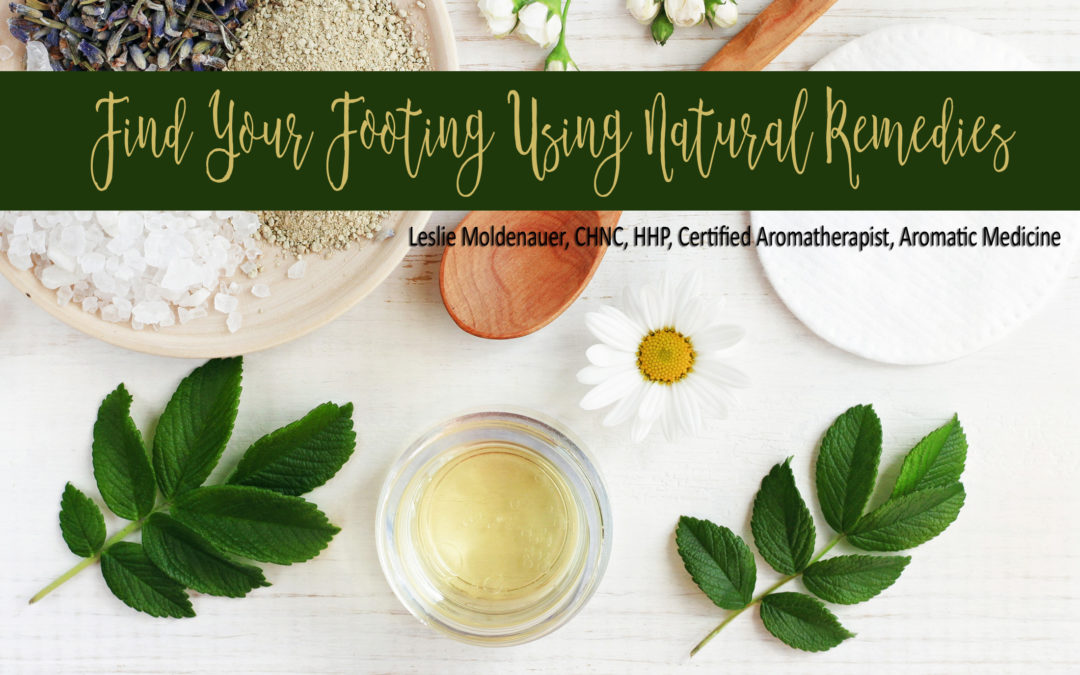
by Leslie Moldenauer | | Essential Oils, Herbs
Are you new to the realm of holistic remedies and therapies? It can be overwhelming. Learning what is safe and appropriate is not an easy task. I receive questions every day about what is safe, what is accurate, and what works. Due to the volume of questions I receive, I think that there may be some tips I can share with you to help you get into the fold. If you are ready to get your feet wet, I am ready to help. Find Your Footing Using Natural Remedies.
Just Do It?
Just do it? Well, maybe to a certain extent. Generally speaking, when looking at herbs such as lavender, chamomile, lemon balm, and elderberry to name a few….these herbs are others are gentle, safe and effective for all ages (This does not include babies exclusively breastfeeding).
One thing I do not recommend….is making Dr. Google an integral part of your research. Googling every symptom you or your child has is going to cause undue stress. Like, a lot of it!
By starting with herbs in the form of tea, for example, you will begin to build confidence, like a muscle, strengthening it with use.
A-ha moments are fabulous for confidence building. I remember a moment 20 years ago when I had an a-ha moment. I had suffered my first miscarriage and was young and confused. A coworker asked me to inhale lavender essential oil when I felt overwhelmed, as it had helped her. What an a-ha moment! What was this absolutely gorgeous heavenly scent in a small little bottle? How was it having such an effect on me? Even in the depths of despair and loss, sitting with the bottle under my nose, curled up in a ball……I was able to feel peaceful. That was the absolute beginning of my path using natural remedies. I was sold….hook, line, and sinker.
A few other great starters would be arnica gel for bumps and bruises, you can purchase it at Target! Elderberry syrup is another first that I recommend to my clients. It is great at the first sign of a cold or flu and is also effective for a cough. You can purchase it OTC at your local pharmacy.
Replace the popular OTC cough drops with Ricola herbal cough drops or reach for local honey (over 1 year of age) for allergy symptoms. These are just a few ways in which you can experiment and find an a-ha moment of your own.k
Start small like I did, just start.
Great Minds Think Alike
Surround yourself with those that share your views, or your curiosities. When you talk to friends who have had success utilizing natural remedies, trying them for yourself seems a bit more attainable. Just be cautious of “this worked great for me” kind of testimonials, especially when it comes to essential oils. There are a couple reasons for this. Essential oils are not always a one-size-fits-all kind of deal. Safe use is also something that needs great consideration. Listen, be inquisitive and hear what others are saying. Essential oils are not (in most cases) strictly placebo. They work, but they need a basic understanding in how to properly use them, as they are potent!
Complementary therapies are steadily becoming more popular. According to the National Center for Complementary and Integrative Health, “in the United States, approximately 38 percent of adults (about 4 in 10) and approximately 12 percent of children (about 1 in 9) are using some form of complementary alternative medicine” [1].
The numbers are steadily growing, and woohoo is it exciting!!!!!
Ask For Help
You can find solid information on some of the very basics online, but reaching out to someone that is well versed in holistic remedies is really important. I see misinformation (well-meaning) every single day online. If you are really, really lucky…you may have found an allopathic doctor that supports your wishes to begin using more natural remedies in the home. Unfortunately, this is a bit rare…although I do feel they are out there.
Great Chiropractors can also be a great find, but also a rare gem when they know CAM in all it’s beautiful and many facets, able to assist you with all of your questions. Unfortunately, we are not there yet, so it is important to find out the true qualifications of those that you are asking for help. Even if they recommend essential oils, have them sitting on the shelves, or are diffusing them in the office, it does not automatically mean they understand safety surrounding their use. You will want to find someone that is honest and will refer you to someone that can help answer your questions if they can’t.
As a practitioner with a degree in CAM, I understand the importance of working within your scope of practice. All professionals need to do the same, but this is not the current reality across the board of CAM practices.
Where herbs and essential oils are concerned, the laymen can learn quite a lot through self-exploration and home study, but I am a firm believer that if you are not ready to seek your own education in the practice, finding a mentor is needed to moving into the true therapeutic practices of any CAM modality.
Are you in the market for a mentor? I will do everything that I can to provide you with just that. There will be many opportunities in the second half of 2018 and beyond to invest in your health and the health of your children/family with more than just one of my typical blogs. Exciting times are ahead!
To your healthy explorations.
Like so many practices in life I encourage you to become educated on the proper use of essential oils. When using them, please do so cautiously, understanding that there is often misinformation on the Internet. You can be assured that I support only educated and proven resources. While essential oils should not be feared they should be respected and used properly to ensure the safety of the individuals using them. Please note that I am not a medical practitioner. The content of the website is provided for general informational purposes only and is not intended as, nor should is be considered a substitute for, professional medical advice. Do not use the information on this website for diagnosing or treating any medical health condition. If you have, or suspect you have a medical problem, promptly contact your professional healthcare provider. By using this website, you assume full responsibility and liability for your own actions.

References
[1] The use of complementary and alternative medicine in the United States. Retrieved from https://nccih.nih.gov/research/statistics/2007/camsurvey_fs1.htm
My Holistic “First Aid” Kit-Essential Oils Herbs & Homeopathy
My Holistic First Aid Kit II
BEFORE YOU GO! Remember to sign up for my FREE Facebook group! Hang out with me and THOUSANDS of other Essential Oil lovers looking to learn, click on to join Real Essential Oil Education Group!
Check out my FREE offer below!

by Leslie Moldenauer | | Cleansing, Essential Oils, Garden
Clean-Air Plants For Your Home. Would you be surprised if I told you that the air in your home was more polluted than your outdoor air? Unfortunately, it is true. According to the EPA, indoor air contains 2 to 5 times more contaminants (1). As stated by Web MD, indoor air pollution is one of the most serious environmental threats to your health, yet no agency can regulate it, and few studies have been done about its effects on your health (2).
Why is our air so toxic? Every single piece of furniture, carpet, shower curtain, in your home is outgassing. Outgassing is releasing chemicals into the air; potentially hazardous VOCs (Volatile Organic Compounds) The synthetic wood, glue, fabric, vinyl, and cushioning are, in effect, evaporating various gases into the air we breathe. Common VOCs found in homes include aldehydes, alcohols, plasticizers, aromatics, alkanes, toxic fire retardants and formaldehyde (3).
You can reduce some of the outgassing by using zero VOC paint (keep in mind adding the color pigment is a VOC), and stick to real wood furniture. (no MDF) Organic mattresses are a great idea considering you spend about 1/3 of your life on your mattress. All store bought mattresses are FULL of chemicals and flame retardants. For this reason, I do not skimp on pillows, mattresses, and bedding; I go organic.
Get yourself a good quality HEPA air filter. This will remove pollutants from the air such as: pet danger, dust mites, pollen and smoke. These still do not address the outgassing. For this I recommend houseplants. Many houseplants moonlight as effective purifiers. Here are my top recommendations:
English Ivy
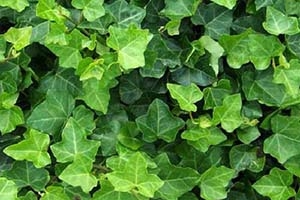
Royalty Free Image
This hearty, climbing vine thrives in small spaces as well as rooms with few windows or little sunlight. So it is quite easy to take care of.
How it Helps: Its aids in the absorption of formaldehyde—which is stated to be the most prevalent indoor pollutant (4).
Concerns: Not safe for animals of children. If you choose to have one, make sure you hang them up and out of their reach, cleaning up fallen leaves immediately.
Peace Lily
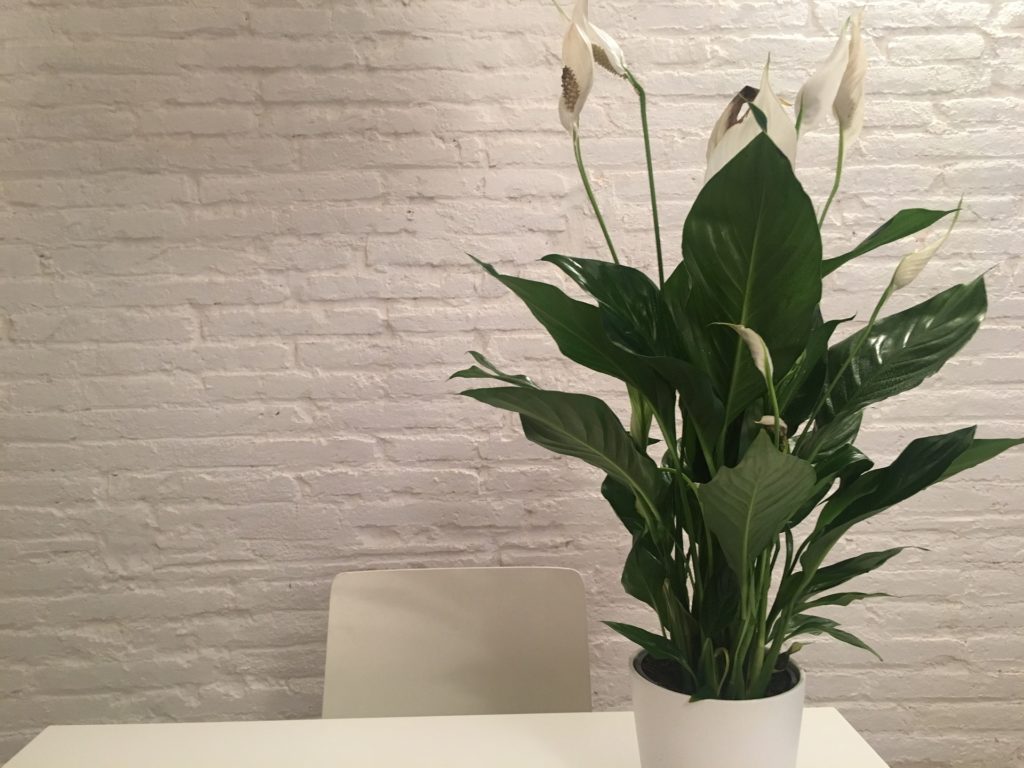
Royalty Free Image
The Peace Lily is a great air purifier that produces dainty white flowers. It will require more water than other houseplants, so a bit more care is required for this plant.
How it Helps: This beauty rids the air of the VOC benzene, which is a carcinogen (5).
Concerns: Like English Ivy, Peace Lily is not for furry friends.
Lady Palm

Royalty Free Image
An easy-to-grow plant, the Lady Palm has leaves patterned like a fan. It is one of my favorite houseplants as it is really hardy, and it my cat decides a leaf should be lunch, it does not result in an upset belly or worse.
How it Helps: This plant targets ammonia in the home. If you are really strict about green cleaning, ammonia is not likely to be in high quantities in the home. Follow the link below to find out where you might find it (6).
Boston Fern
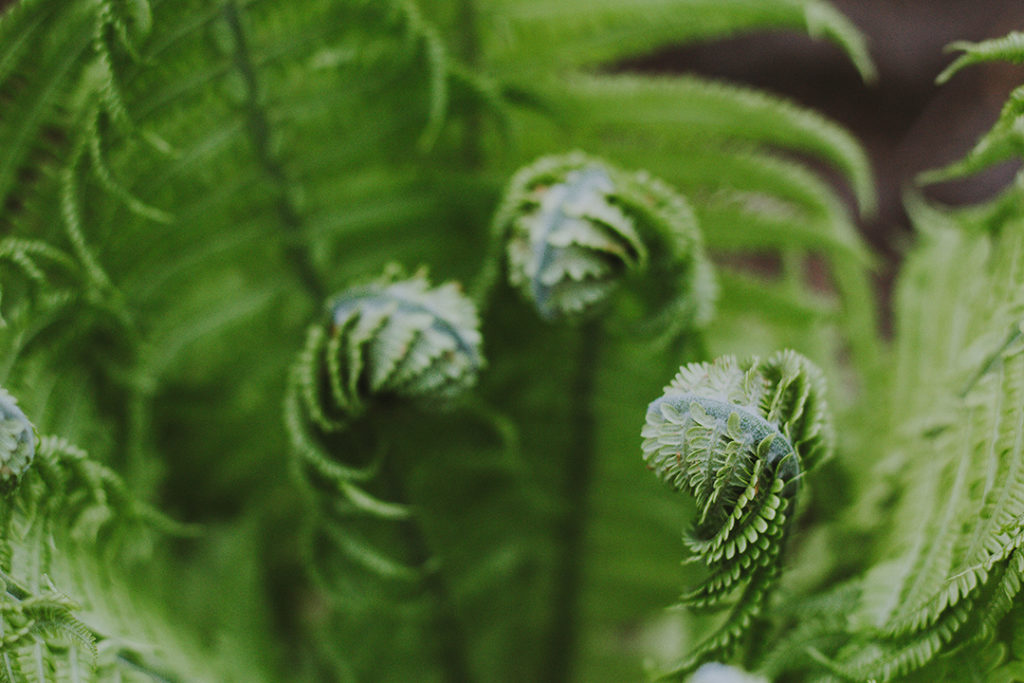
Royalty Free Image
The Boston Fern that is best in a hanging basket, but if not cared for, it will die fast. It requires humidity and moisture. It will drop leaves fast without it. It’s considered one of the most efficient air purifiers!
How it Helps: According to NASA, “Ferns work by absorbing formaldehyde, benzene, trichloroethylene, xylene, and toluene and reducing peoples’ exposure to those nasty airborne chemicals” (7).
Snake Plant
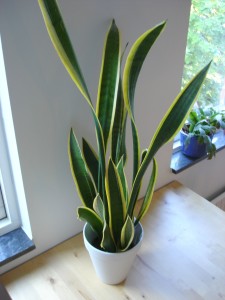
Image courtesy of DenGarden.com
Also known as mother-in-law’s tongue, this plant does not require too much sunlight or water to thrive.
How it Helps: The Snake Plant lowers carbon dioxide, as well as formaldehyde and benzene (8).
Concerns: Not safe for furry friends.
Spider Plant
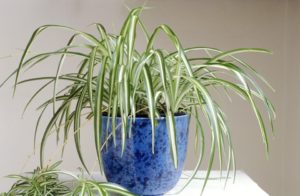
Image courtesy of thespruce.com
Lastly is the Spider Plant. Another favorite as it is safe for my cats. It does require care, not a plant that you can set it down and forget it. It needs some direct light and plenty of water. Can also work as a hanging plant.
How it Helps: According to a NASA clean air study, “spider plants can filter formaldehyde, xylene, and toluene from the air” (9).
As you can see there are many options for houseplants to remove harmful VOC’s in the home. Please double check and make sure what you choose is appropriate for children as well as pets.
References
(1) Introduction to Indoor Air. Retrieved from https://www.epa.gov/indoor-air-quality-iaq/introduction-indoor-air-quality
(2) Having a Bad Air Day? Improve Your Indoor Air Quality. Retrieved from https://www.webmd.com/women/features/indoor-air#1
(3) 10 surprising sources of off-gassing in your home, and what you should do about it. Retrieved from https://www.treehugger.com/green-home/10-surprising-sources-gassing-your-home-and-what-you-should-do-about-it.html
(4) Indoor air pollution: An evaluation of three agents. Retrieved from http://enhs.umn.edu/current/5103/air/formaldehyde.html
(5) Benzene. Retrieved from https://toxtown.nlm.nih.gov/text_version/chemicals.php?id=5
(6) Which Cleaning Products Contain Ammonia? Retrieved from https://www.hunker.com/12207552/which-cleaning-products-contain-ammonia
(7) Ferns, clean air, & NASA. Retrieved from http://www.casaflora.com/media-2/ferns-are-clean/
(8) Snake plant, everything you need to know. Retrieved from https://www.rollingnature.com/blogs/news/snake-plant-everything-you-need-to-know
(9) NASA Clean Air Study. Retrieved from https://en.wikipedia.org/wiki/NASA_Clean_Air_Study
BEFORE YOU GO! Remember to sign up for my FREE Facebook group! Hang out with me and THOUSANDS of other Essential Oil lovers looking to learn, click on to join Real Essential Oil Education Group!
Check out my FREE offer below!
Please note that I am not a medical practitioner. The content of this website is provided for general informational purposes only and is not intended as, nor should it be considered a substitute for, professional medical advice. Do not use the information on this website for diagnosing or treating any medical or health condition. If you have or suspect you have a medical problem, promptly contact your professional healthcare provider. By using this website, you assume full responsibility and liability for your own actions.


















